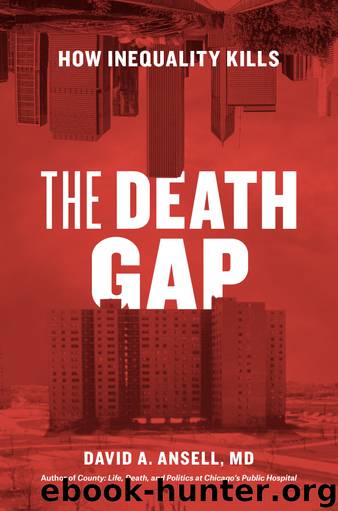The Death Gap by David A. Ansell MD

Author:David A. Ansell, MD [Ansell, MD, David A.]
Language: eng
Format: epub
ISBN: 978-0-226-42829-1
Publisher: University of Chicago Press
Published: 2017-03-29T04:00:00+00:00
Implicit Bias Contributes to Unequal Care
While the story of the Chicago breast cancer death gap has had early success, in too many areas and on too many levels we are still dealing with the most basic inequities and prejudices. Bias, even if unconscious, affects individual physicians and their treatment decisions. This is unsettling but true. While most doctors do not exhibit explicit racial bias, such as refusing to treat certain patients because of their race, on tests of implicit bias they, too, show unconscious preferences for whites over dark-skinned faces. The Implicit Association Test is a widely used test of social cognition. More than 70 percent of the millions of Americans who have taken it exhibit a subconscious preference for whites over blacks.30 Physicians score similarly.
An ingenious 1999 experiment showed how unconscious bias affects clinical decision making. Thousands of doctors were asked to test their clinical acumen by reviewing the medical history given by a performer who acted out the symptoms of a potential cardiac syndrome on film.31 There were eight elderly patients. Four were men: two white and two black. Four were women: two white and two black. Physicians were asked to recommend a cardiac workup based on the clinical information the patients relayed. In addition, physicians were told whether the patient was insured or uninsured.
The results were not surprising. Based on the gender, race, and insurance status of the patient, doctors recommended entirely different medical workups. Men of both races were more likely to be referred for angiograms to evaluate symptoms of chest pain. But blacks of both genders were less likely than the whites to be referred for the full cardiac workup. Those who were noted to be insured were more likely to be referred for a full workup as well. While this was an experiment and not real clinical care, unconscious bias in health care delivery seems to be a real phenomenon.
In an eye-opening 2002 report on health care disparities, the Institute of Medicine found “strong but circumstantial evidence for the role of bias, stereotyping, and prejudice” in perpetuating racial health disparities.32 Some research suggests that there is a direct relationship among physicians’ implicit bias, mistrust on the part of black patients, and clinical outcomes.33 In a prospective study of older adults, patients who experienced discrimination in health care more than once yearly were twice as likely to have a disability four years later than cohort members who suffered no discrimination.34
What needs to be done to address implicit bias in medicine? Awareness is a start. Mandatory bias testing and cultural intelligence training have been proposed. But it requires day-to-day interactions between people of different backgrounds to break the implicit boundaries that prevent deeper understanding.35 And that’s necessary, but fair. But bias is only a piece of the story.
Download
This site does not store any files on its server. We only index and link to content provided by other sites. Please contact the content providers to delete copyright contents if any and email us, we'll remove relevant links or contents immediately.
| Anthropology | Archaeology |
| Philosophy | Politics & Government |
| Social Sciences | Sociology |
| Women's Studies |
Cecilia; Or, Memoirs of an Heiress — Volume 1 by Fanny Burney(32434)
Cecilia; Or, Memoirs of an Heiress — Volume 2 by Fanny Burney(31871)
Cecilia; Or, Memoirs of an Heiress — Volume 3 by Fanny Burney(31854)
The Great Music City by Andrea Baker(31349)
We're Going to Need More Wine by Gabrielle Union(18967)
All the Missing Girls by Megan Miranda(15571)
Pimp by Iceberg Slim(14394)
Bombshells: Glamour Girls of a Lifetime by Sullivan Steve(13973)
Talking to Strangers by Malcolm Gladwell(13222)
Norse Mythology by Gaiman Neil(13206)
Fifty Shades Freed by E L James(13157)
For the Love of Europe by Rick Steves(12992)
Mindhunter: Inside the FBI's Elite Serial Crime Unit by John E. Douglas & Mark Olshaker(9201)
Crazy Rich Asians by Kevin Kwan(9167)
The Lost Art of Listening by Michael P. Nichols(7406)
Enlightenment Now: The Case for Reason, Science, Humanism, and Progress by Steven Pinker(7234)
The Four Agreements by Don Miguel Ruiz(6631)
Bad Blood by John Carreyrou(6552)
Weapons of Math Destruction by Cathy O'Neil(6146)
